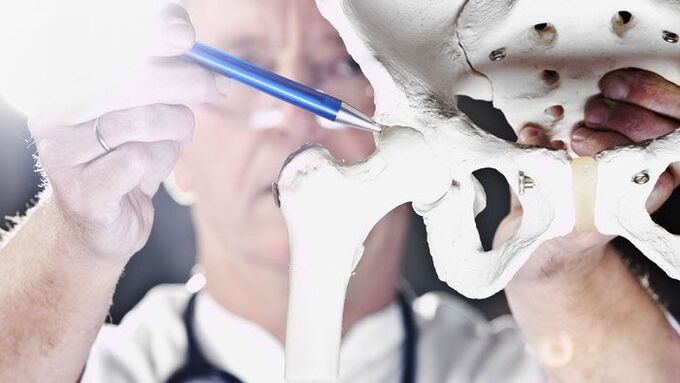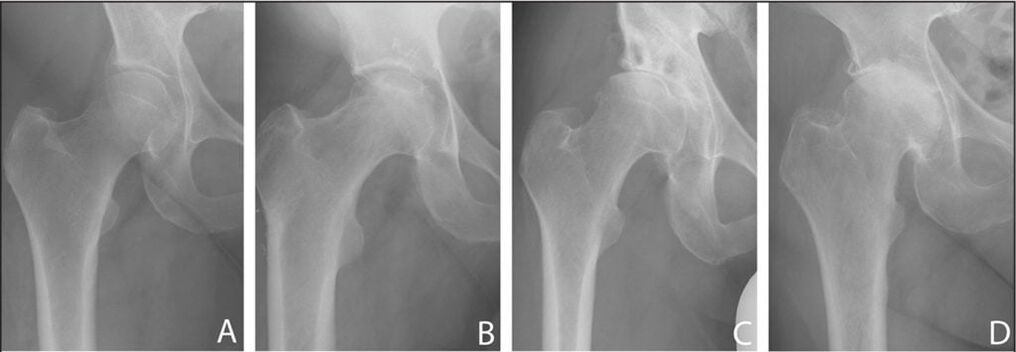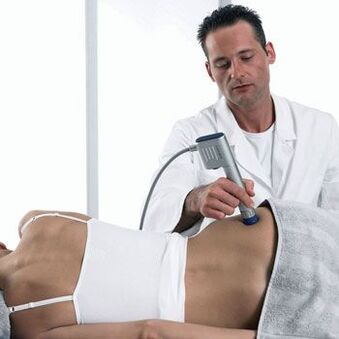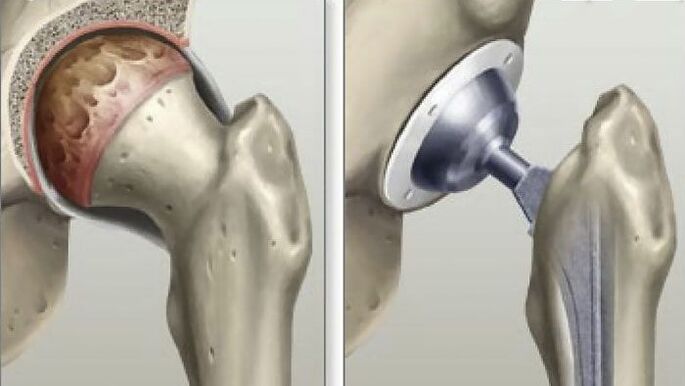
One of the most severe pathologies in the musculoskeletal system is coxarthrosis of the hip joint. If a visit to a medical facility is delayed, the disease can develop - until the appearance of an acute pain syndrome, which cannot be relieved with analgesics, and a complete loss of joint motor ability.
In this article we will talk in detail about all the nuances related to eliminating the consequences of this pathological process, its stages and preventive procedures.
What is coxarthrosis of the hip joint?
We are talking about degenerative-dystrophic disease of the hip joint in severe form, which can provoke a violation of the joint's functional capacity, up to its absolute loss. In terms of the frequency of manifestations, coxarthrosis is in the second position after arthrosis of the deformed knee joint.

Coxarthrosis of the hip joint is accompanied by degenerative damage to the cartilage, the appearance of pathological growth, bone resorption, inflammatory processes and other complications.
That is, this pathology is characterized by damage to the entire joint, which includes cartilage tissue, synovial layer, subchondral bone plate, muscle structure, capsule and ligaments.
The following forms of the disease are also distinguished:
- Primary coxarthrosis. It is considered the most common disease of the hip joint. In older people, this pathology manifests itself against the background of age-related changes;
- Secondary coxarthrosis. Manifests itself as a result of any disease.
Causes of coxarthrosis
The development of pathology can be provoked by reasons of external nature, acquired and hereditary.
In particular, coxarthrosis can manifest itself against the background of congenital inferiority of the hip joint, degenerative-dystrophic changes, trauma, inflammatory processes, bone marrow necrosis of the femoral head, metabolic disorders, genetic factors, age-related changes, obesity. , vascular abnormalities, and work in difficult conditions.
It should be noted that almost all joint structures are subject to inflammation.
3 stages of development of coxarthrosis of the hip joint
During the development of the pathological process, the viscosity of the joint fluid increases, which causes the appearance of microcracks and leads to dehydration of the cartilage surface. This, in turn, contributes to a crunchy appearance and limited mobility. A person feels unpleasant manifestations during daily stress and physical activity. As the pressure on the bottom increases, the tired joint adapts to the forced position and begins to destroy nearby structures.
Currently, there are 3 stages of disease development:
- First. Coxarthrosis of the hip joint at this stage has inconsistent mild symptoms and appears in the affected area. At the same time, motor activity is preserved, and to relieve pain, it is enough to take medicine;
- Second. When a patient is diagnosed with coxarthrosis of the hip joint at stage 1, the disease does not cause much discomfort, but when it reaches stage 2 of the disease, the symptoms become more pronounced. The pain became stronger and began to radiate to other parts of the body. Motor ability deteriorates significantly, which becomes very noticeable after long walks or increased physical exertion;
- Third. If coxarthrosis of the hip joint of the 2nd degree is still treatable, in the third stage the pathology becomes chronic. It is accompanied by constant pain and is sent to the lower part of the body. The patient loses the ability to move without crutches. In the absence of proper therapeutic measures, atrophy of the cartilage and muscle structure occurs.
Types of coxarthrosis
The classification of hip joint pathology is based on one criterion - how the disease arises in the musculoskeletal system. There are two main risk factors that can trigger the onset of the disease - genetic and acquired as a result of age-related changes. The pathological process is also divided into several types, depending on the source of the event:

- Primary coxarthrosis. This pathology manifests itself in the hip area and is acquired. At the initial stage, it affects the synovial capsule, after which it enters the tissue area surrounding the joint. Risk factors include increased pressure on the pelvic bones, excessive physical activity, and the presence of inflammatory foci in the lower legs and spine. Degenerative lesions are concentrated in tissues that have undergone changes;
- Secondary coxarthrosis. This anomaly is hereditary. It manifests itself in the joints and musculoskeletal system. The development of the pathological process can begin in the uterus after a woman receives an injury, as well as against the background of bone marrow necrosis of the femoral head.
Types of coxarthrosis are caused by:
- Post infection. Identified by the presence of consequences after an infectious disease;
- After trauma. Diagnosis in case of complications after limb injury;
- not hormones. Occurs against the background of metabolic disorders or drug overdose;
- Involutive. It appears in people over 50 years old due to aging of the body.
Diagnostic steps
If you suspect grade 1 or 2 coxarthrosis of the hip joint, before starting treatment, you should do a full body examination. It is also important to get a consultation with an orthopedic doctor, who will perform an examination, give recommendations on laboratory tests and draw up an effective treatment plan. Typically, diagnostic steps are limited to the following procedures:
- Radiography. Allows you to study the parameters of the gap between the cartilages, diagnose the presence of pathological growth, and also assess the condition of the femoral head;
- Ultrasonography. Makes it possible to detect the etiology of changes in the structure of bones and ligaments, as well as study the dynamics of the patient's condition and determine the degree of development of anomalies;
- CT. Allows you to get more detailed information about the condition of joints and tissues located near them;
- MRI. This method provides a detailed picture of the condition of all hip joint structures.
Treatment of coxarthrosis of the hip joint
If the patient has been diagnosed with coxarthrosis of the hip joint 1 or 2 degrees, it is possible to get effective results through conservative methods. Such therapy is prescribed to the patient individually and includes several techniques, which only together give a positive effect. Therefore, if the patient is diagnosed with coxarthrosis of the hip joint 1 or 2 degrees, and the corresponding symptoms are observed, the following measures may be recommended:
- Use of medications;
- Physiotherapy procedures;
- Shock wave therapy;
- Physiotherapy.
To achieve positive dynamics using conservative methods, the causes that cause coxarthrosis of the hip joint should be eliminated. First of all, you should lose weight, which will reduce the load on the joints and minimize the possibility of further development of the degenerative-dystrophic process.
In addition, you should eliminate the use of tobacco products and increase physical activity, avoiding excessive effort. To prevent the development of pathology, experts advise the use of orthopedic devices (orthoses and bandages). They allow you to firmly fix the joints and provide the necessary support during physical activity.
Medicines
Medicines are also prescribed individually. As a rule, patients are recommended to take the following drugs:

- Nonsteroidal anti-inflammatory drugs. These drugs allow you to get a double effect: relieve pain and eliminate the inflammatory process;
- Preparations containing chondroitin, glucosamine and collagen. They allow you to activate the recovery process in the cartilage;
- Steroid hormones. A drug with a strong anti-inflammatory effect. Used in situations where NSAIDs are not significantly effective;
- Relax the muscles. Drugs that relax muscle tone, which is a necessary condition to relieve pain with increased intensity;
- Means that normalizes blood circulationand increase tissue trophism located near the joint;
- Vitamin B. Complexes containing this vitamin are prescribed to improve nerve transmission, which is very important when the ends are compressed by the affected structure.
In case of pain with significant intensity, it is also recommended to perform a periarticular block. They are carried out only under the supervision of a professional expert in a clinical setting. In this case, a special solution with steroid hormones and anesthetic is injected into the joint.
Gymnastics for coxarthrosis of the hip joint
Particularly effective in restoring motor function and reducing muscle spasms are special exercises recommended to be done for coxarthrosis of the hip joint. Due to the optimally selected load, it is possible to relieve pain and increase the amplitude of movement. In addition, a properly arranged complex allows you to prevent atrophic processes in the muscles and relieve spasms if pinched nerve endings are observed against the background of the disease.

Also, gymnastics for coxarthrosis of the hip joint helps increase blood flow in the affected area and allows you to speed up the recovery process.
When choosing exercises, the specialist must take into account the destruction of the hip joint and the physical condition of the patient.

Physiotherapy methods
Massage and physiotherapy procedures can provide special analgesic, anti-inflammatory and decongestant effects. They also help maintain muscle tone in the limbs, preventing atrophic processes.
For hip joint abnormalities, the following procedures are performed:
- UHF;
- Laser exposure;
- Ultrasound treatment;
- Magnetotherapy;
- Exposure to direct electric current in combination with medications;
- Paraffin therapy;
- Phonophoresis.
The above treatment will give a positive effect only if the patient has been diagnosed with coxarthrosis at the primary stage.

Shock wave therapy for coxarthrosis
For coxarthrosis of the first or second degree, shock wave treatment provides significant positive dynamics. For example, a course of 10-15 shock wave therapy procedures can reduce the characteristic negative manifestations of stage 2 pathology to signs of the early stages of the disease.
It is important to understand that only timely treatment sessions can provide the best recovery effect. At the same time, it is possible to reduce the number of SWT procedures.
However, the main positive aspect when affecting the affected joints with shock waves is the ability to normalize blood circulation, which facilitates the accelerated supply of important nutrients involved in the regenerative process to the various structures of the hip joint.
In addition, as part of the implementation of shock wave therapy, it is possible to destroy pathological bone growth, which contributes to significant irritation of articular tissue and prevents regrowth.
Physiotherapists and neurologists with professional experience operate in clinics. They are fluent in working with the latest physiotherapeutic methods, including the shock wave method. In addition, specialists have the ability to work with modern equipment. This gives a guaranteed positive effect and allows you to shorten the treatment period.
Surgery
Unfortunately, many patients delay contacting a medical facility and see a specialist only when irreversible processes begin to occur in the hip joint.

For the third or fourth advanced stage of the disease, the only effective method is surgery. It will restore motor ability and eliminate acute pain, that is, significantly improve the patient's quality of life.
As a rule, surgery is prescribed in the following situations:
- Painful sensations with increasing intensity that cannot be relieved with drugs;
- Lack of interarticular space;
- Violation of the integrity of the femoral neck;
- Significant limitation of physical activity.
Given the intensity of joint damage and changes in bone tissue, patients may be prescribed the following types of intervention:
- Arthrodesis. Interventions that create complete immobility of the joint. For this purpose, a special metal plate is used;
- Osteotomy. Surgical intervention consisting of an artificial fracture of the femur to straighten its axis. The resulting part is placed in the most optimal position, which allows you to remove excess load from the affected joint;
- Arthroplasty. The only method in which it is possible to restore all the functions of the hip joint and achieve a complete recovery of the patient. After using this method to eliminate coxarthrosis, a person forgets about problems with joints for 20-30 years.
The medical center performs surgical procedures in the hip joint area of any complexity. They are carried out by highly qualified specialists using modern tools and technologies, which eliminate any errors during intervention.
Complications of the disease
When the pathological process is at an advanced stage, the mobility of the joints is very limited, a person loses the ability to walk and take care of himself, and pathological tissue fusion is observed. In addition, such anomalies can have an undesirable effect on gait, which is caused by the appearance of lameness and a reduction in the size of the limbs.
Preventive measures
Patients who experience pain in the hip joint should be observed by a specialist and use special orthopedic devices when doing work and physical activity. In addition, after surgery, it is necessary to undergo radiography 3 times a year to monitor the condition of the joint.

















































